Instruments
sdsd
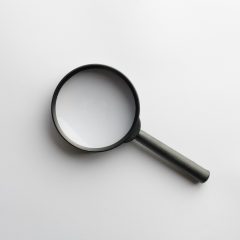
Instrumentation and services are available to all researchers inside and outside of the university.
Researchers from the Northwestern University and the University of Chicago are provided internal rates as all UIC users. All other users can access services but at an external academic or external non-academic rate, which is determined using subsidy and market rates.
All users are responsible for their own laboratory safety training to be current during each use of the core facilities.
Scheduling
Please email Hyun Lee (danielhl@uic.edu) to schedule a meeting or a training. Once you become an approved self-user, you can do on-line scheduling by yourself using UICore.
Instruments
| Instrument Name | Manufacturer | Model | Location | Training |
|---|---|---|---|---|
| Biacore T200 | Cytiva (former GE Healthcare) | Biacore T200 | CfSB room 113 | Available |
| Biacore 8K | Cytiva (former GE Healthcare) | Biacore 8K | CfSB room 113 | Available |
| Integra VIAFLO384_96 Pipette Head | Integra | VIAFLO384 | CfSB room 113 | Available |
| VP- ITC MicroCalorimeter | MicroCal,LLC | VP-ITC | CfSB room 113 | Available |
| PEAQ- ITC MicroCalorimeter | MicroCal,LLC | PEAQ-ITC | CfSB room 113 | Available |
| Refeyn TwoMP Mass Photometer | Refeyn Inc | TwoMP | CfSB room 113 | Available |
| Jasco 815 Circular Dichroism(CD) | Jasco | J-815-150S | CfSB room 113 | Available |
| AKTA Pure FPLC | Cytiva (Former GE Healthcare) | AKTA Pure | CfSB room 115 | Available |
| NanoDrop Micro-UV/Vis Spectrophotomenter | Thermo Scientific | NanoDrop One | CfSB room 115 | Available |
| C25KC Incubator shaker | New Brunswick Scientific | C25KC | CfSB room 115 | Available |
| Inova 4200 Incubator shaker | Inova | 4200 | CfSB room 115 | Available |
| Centrifuge_Sorvall LYNX 4000 | Sorvall | Lynx4000 | CfSB room 115 | Available |
| Emulsiflex C5 Homogenizer | Avestin | Emulsiflex C5 | CfSB room 118 | Available |
| Sonic Dismembrator Model500 Sonicator | Thermo Fisher Scientific | Model 500 | CfSB room 118 | Available |
| Fisher Scientific 60 Sonic Dismembrator | Thermo Fisher Scientific | Model 60 | CfSB room 118 | Available |
| PerkinElmer Victor3V plate reader | PerkinElmer | Victor3V 1420-040 | CfSB room 118 | Available |
| C280 Azure Biosystem | Azure Biosystems | C280 | CfSB room 118 | Not Available |
Biacore T200 (Surface Plasmon Resonance)
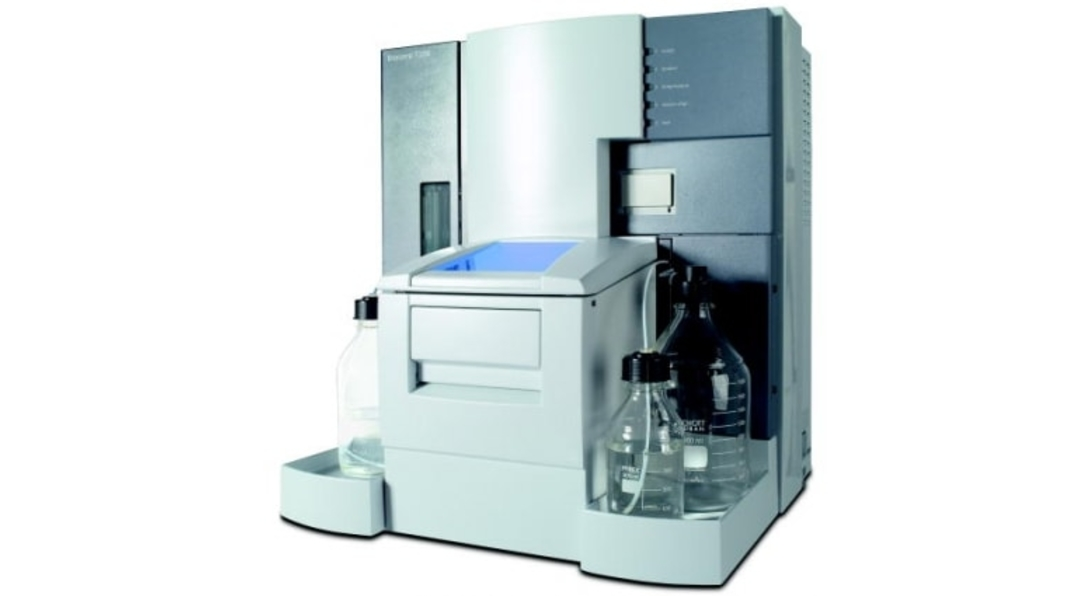
Location: CfSB (Center for Structural Biology) Room 113
Description: The Biacore T200 is a very advanced SPR instrument that can support real-time detection and monitoring of the biomolecule interactions such as proteins-proteins, proteins-peptides, proteins-DNA, and proteins-compounds. Our Biacore T200 can detect from large protein complexes (> 100 kDa) to a very small fragment compounds (< 100 Da), and it can provide quantitative information on binding specificity, binding affinity, kinetics, and concentration. This technique can also be applied to every stage of drug-discovery, which includes mid-throughput automated compound screening, hit confirmation and validation, hit characterization via kinetics, and mechanism of action.
Biacore 8K (Surface Plasmon Resonance)
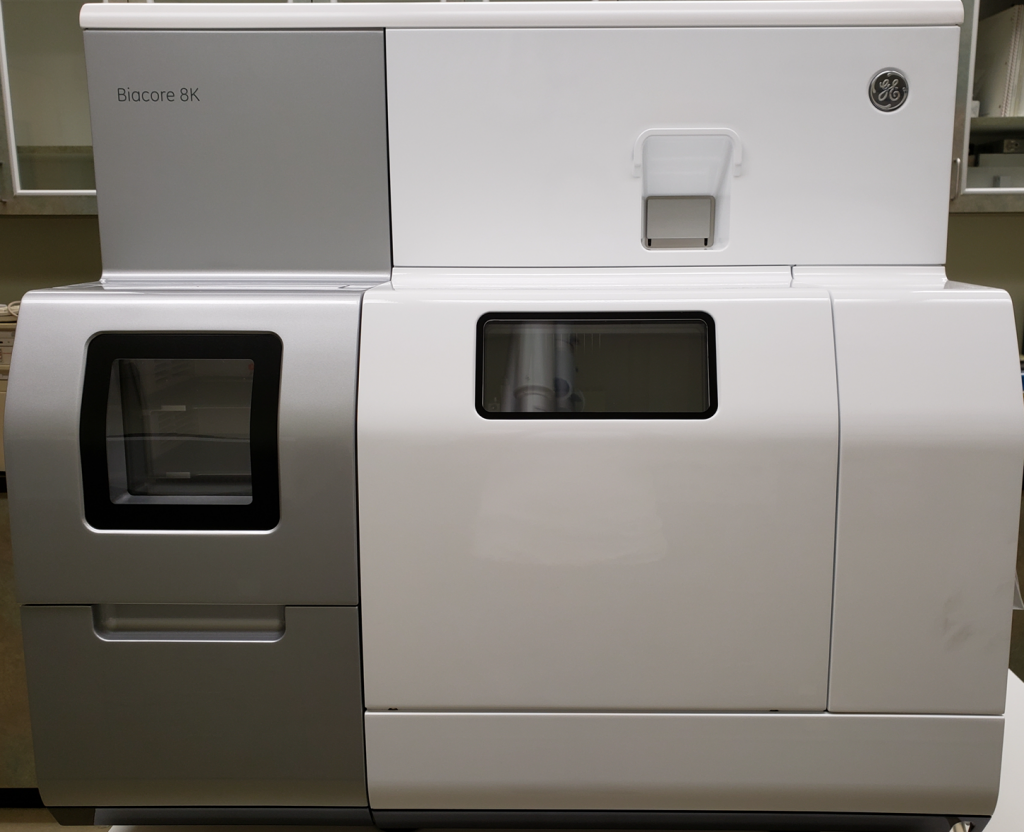
Location: CfSB (Center for Structural Biology) Room 113
Description: Biacore 8K is an eight-needle high-sensitivity surface plasmon resonance (SPR) system rapidly provides kinetics and affinity data shortening time to results by up to eight times compared to single-needle systems. The blend of system flexibility and throughput reduces the experimental cycle time, even for complex targets and new drug formats such as bispecific antibodies.
- A single solution for interaction analysis in both screening and characterization
- Screening of 2300 small-molecule fragments in a day
- High-quality kinetic characterization of 64 interactions in 4 h
- 60 h unattended runtime with queueing abilities and rapid multirun evaluations
- Confident interaction analysis of small molecules binding to complex targets such as GPCRs
- Confident differentiation of high-affinity binders
Jasco 815 Circular Dichroism (CD) Spectrometer
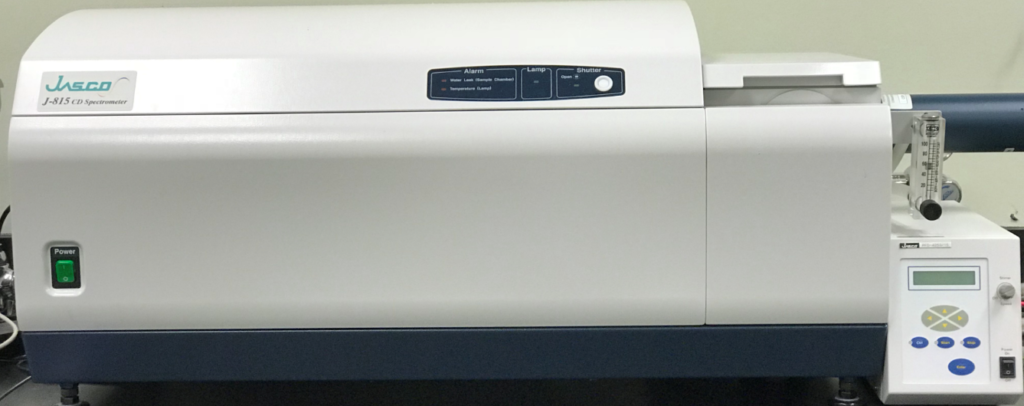
Location: CfSB (Center for Structural Biology) Room 113
Description: Circular dichroism measures the interaction of circularly polarized light with molecules. Circularly polarized light interacts equally with non-chiral molecules so non-chiral molecules are not measured. As the circularly polarized light passes through an optically active substance, its two circularly polarized components travel at different speeds and are absorbed in differing degrees. The Jasco 815 CD spectrometer can measure conformation in chiral molecules. CD spectra between 260 and approximately 190 nm can be analyzed for secondary structural elements: alpha helix, parallel and anti-parallel beta sheet, turn, and other. The absence of regular structure results in zero CD intensity, while an ordered structure reveals a spectrum that can contain both positive and negative signals.
- Characterization of protein secondary and tertiary structure
- Studying the conformational stability of a protein at varying temperature, pH or denaturant concentrations
- Determination of the effects of protein-protein interactions on conformation
- Comparing the structures of protein vs. mutants or proteins expressed in different systems
Analytical Ultracentrifugation (AUC)
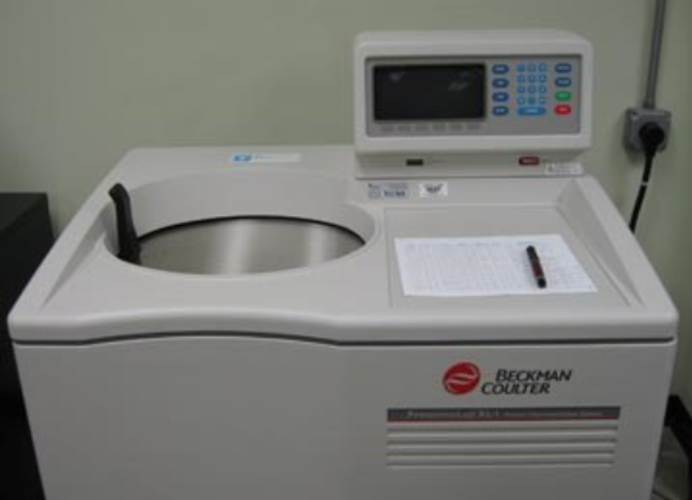
Location: CfSB (Center for Structural Biology) Room 115
Description: The Beckman ProteomeLab XL-1 measures concentration distributions of a sample in solution in a centrifugal field. The application of centrifugal force causes a redistribution of the macromolecules and the formation of a concentration boundary that moves from the meniscus to the bottom of the cell over time. A significant strength of technique is that the properties of native proteins are studied in solution -requiring no label, chemical modification or surface interaction.
The XL-1 is equipped with two optical detection systems. The first is capable of reading the absorbance of a sample using a dual-beam UV/VIS spectrophotometer with monochromator. The second detection system uses a laser interferometer that records the refractive index gradients. The choice of the optical detection system depends on the sensitivity needed for the experiment, the concentration range to be used, the extinction properties of the system and the buffer properties.
Two methods used for running the analytical ultracentrifuge are sedimentation velocity and sedimentation equilibrium. In sedimentation velocity, high rotor speed sediments macromolecules to the bottom of the cell. The rate of sedimentation is dependent on the size and the shape of the protein. Sedimentation velocity experiments generally run for 6 – 12 hours. Sedimentation equilibrium experiments are run at lower rotor speeds where the process of sedimentation is balanced by diffusion. When no change in the concentration distribution is detectable, sedimentation equilibrium is achieved. The time required to establish sedimentation equilibrium is generally 1 -2 days with the entire experiment typically taking between 3 and 5 days.
- Determine the molar mass of proteins and complexes
- Assess the purity of a sample
- Determine the number of species in a sample
- Determine the stoichiometry of complexes
- Analysis of self- and hetero-association
- Determine binding constants (10-3– 10-8 M)
- Characterizes synthetic polymers, biological macromolecules, viral particles, carbohydrates and nanoparticles
Isothermal Titration Calorimetry (ITC)
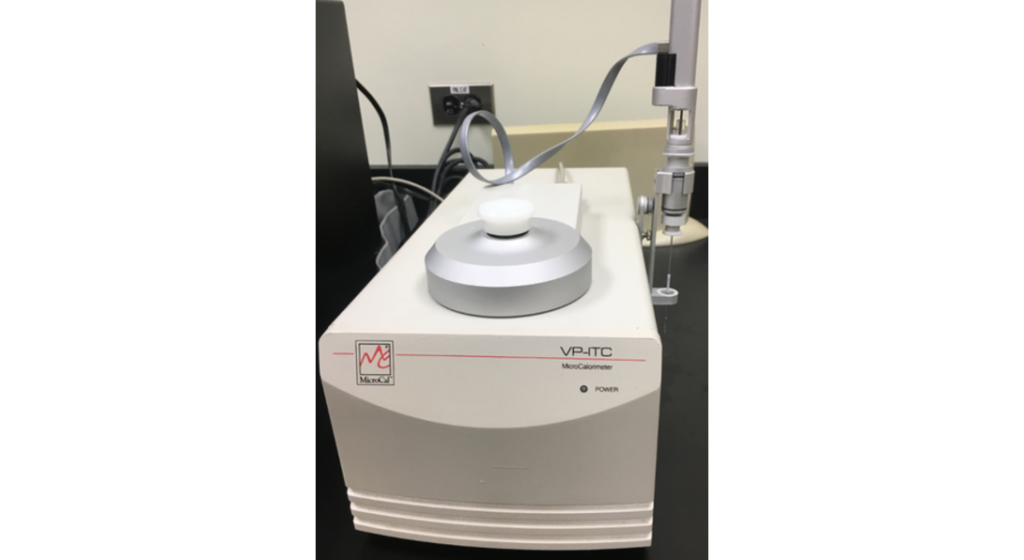
Location: CfSB (Center for Structural Biology) Room 113
Description: The MicroCal VP-ITC is useful for the characterization of the thermodynamics of a binding reaction in solution. In an ITC experiment, aliquots of a titrant (typically a protein, peptide or small molecule) are injected into the cell containing a macromolecule solution. With each titration injection, the molecules interact and heat is either generated or absorbed. The VP-ITC measures this heat of binding to determine the binding constants (K), reaction stoichiometry (n), enthalpy (ΔH) and entropy (ΔS). In addition, varying the temperature of the experiment allows the determination of the heat capacity (ΔCp) for the reaction. Since the heat of binding is a naturally occurring event, the ITC does not require immobilization and/or modification of the reactants. There are no limits on the protein or ligand size nor is the system dependent on the optical properties of the samples. The major limitation of the ITC is that it requires relatively high concentrations of samples.
- To monitor binding interactions, such as but not limited to: antigen-antibody, DNA-drug, receptor-target, protein-ligand or protein-protein
- Determination of reaction stoichiometry
- Measurement of binding constants
- To measure the thermodynamic properties of binding – enthalpy, entropy and Gibbs free energy
Emulsiflex C5 (Cell lysis)
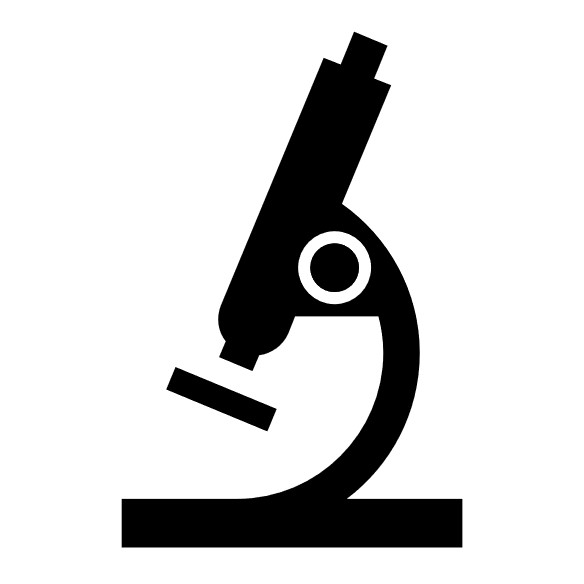
Location: CfSB (Center for Structural Biology) Room 118
Description: The Emulsiflex C5 is a gas driven homogenizer designed for high-volume cell lysis. Cells are resuspended in buffer and passed through the system under high pressure. Unlike a French Press and Sonication, the volume of resuspended cells is virtually limitless, and heating of the sample is minimal.
- Efficient lysis of bacterial cells
- Only Biosafety Level One cultures are permitted
PerkinElmer Victor3V plate reader

Location: CfSB (Center for Structural Biology) Room 118
Description: A general-use spectrophotometer with multiple detection capabilities:
- Fluorescence intensity (top & bottom reading)
- Fluorescence Resonance Energy Transfer(FRET)
- Absorbance (UV to NIR range)
- luminescence